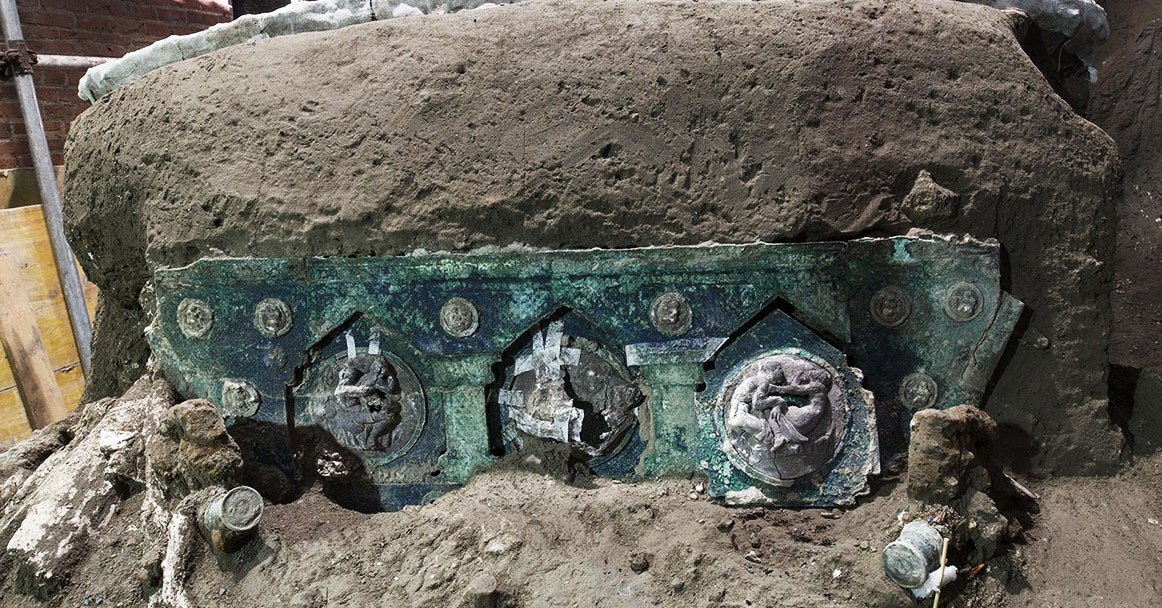
Archaeologists in Italy have unearthed an elaborately decorated, intact four-wheeled ceremonial chariot near the ruins of the Roman city of Pompeii, famously destroyed when Mount Vesuvius catastrophically erupted in 79 CE, BBC News reports. The archaeologists believe the chariot was likely used in festivities and parades—possibly even for wedding rituals, such as transporting the bride to her new home, given the erotic nature of some of the decorative motifs.
The find is extraordinary both for its remarkable preservation and because it is a relatively rare object. “I was astounded,” Eric Poehler, a professor at the University of Massachusetts Amherst who is an expert on traffic in Pompeii, told NPR. “Many of the vehicles [previously discovered] are your standard station wagon or vehicle for taking the kids to soccer. This is a Lamborghini. This is an outright fancy, fancy car. This is precisely the kind of find that one wants to find at Pompeii, the really well-articulated, very-well-preserved moments in time.”
Other archaeologists weighed in on Twitter. “My jaw is on the floor just now!” tweeted Jane Draycott of the University of Glasgow. “Still wrapping my head around the latest incredible discovery,” Sophie Hay of the University of Cambridge tweeted in an extensive thread about the surprising find. “The details are extraordinary.”
As we’ve previously reported, the eruption of Vesuvius released thermal energy roughly equivalent to 100,000 times the atomic bombs dropped on Hiroshima and Nagasaki at the end of World War II, spewing molten rock, pumice, and hot ash over the cities of Pompeii and Herculaneum in particular. The vast majority of the victims died of asphyxiation, choking to death on the thick clouds of noxious gas and ash. But there is also some evidence that the heat was so extreme in some places that it vaporized body fluids and exploded the skulls of several inhabitants unable to flee in time.
The sudden eruption covered the remains of the city in a thick layer of ash, preserving many of the buildings and daily ephemera of the doomed city—and the bodies of its former inhabitants. There have been several exciting archaeological finds among the excavated ruins in recent years. In December, for instance, archaeologists unearthed a termopolium, or “hot drinks counter,” that served up ancient Roman street food—and plenty of wine—to the people of northeast Pompeii in the days before Mount Vesuvius erupted. Painted bright yellow and decorated with detailed frescoes, the counter would have been a quick stop for hot, ready-made food and drinks. And the small shop still held the remains of its proprietor and perhaps one of its last customers.
Late in 2018, the remains of a horse—saddled up and still in its harness—were uncovered in a stable at the Villa of the Mysteries just outside Pompeii’s walls. Previous finds at the site include wine presses, ovens, and frescoes. The remains of two additional horses were also discovered, although archaeologists were unable to make casts to preserve the scene due to damage done by looters. After the initial excavation of the site in the 20th century, it was reburied for the sake of preservation. But looters dug an elaborate network of tunnels around the area—running some 80 meters and more than 5 meters deep—to illegally gain access and remove artifacts.
The ceremonial chariot was found in the ruins of the two-level portico facing the stable where the horse remains were found in 2018. Archaeologists had carefully removed the carbonized wood ceiling and determined that it had been constructed from oak, while the carbonized door had been made of beechwood. On January 7 of this year, archaeologists found an iron artifact in the volcanic material filling the portico, followed by the ceremonial chariot, which was remarkably well-preserved, given that the walls and ceiling of the room had collapsed and the looters had dug tunnels on either side of it.
The archaeological team spent the next several weeks meticulously unearthing the find, making plaster casts of any voids to preserve the imprint of any organic material that may have once been there—including the chariot’s shaft and ropes. The chariot has since been removed to the Archaeological Park of Pompeii’s laboratory to complete its restoration.


